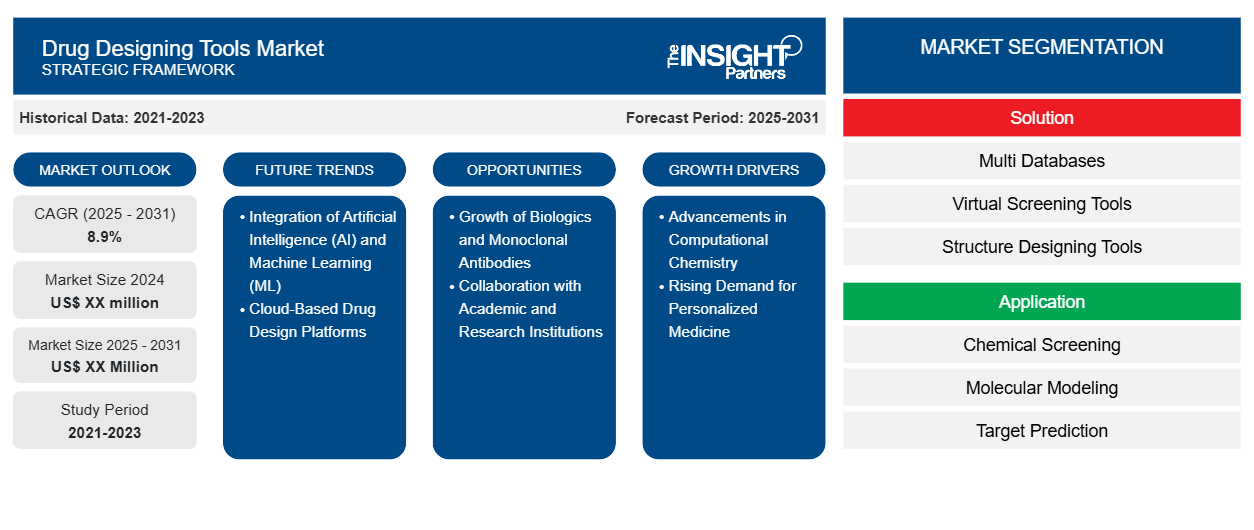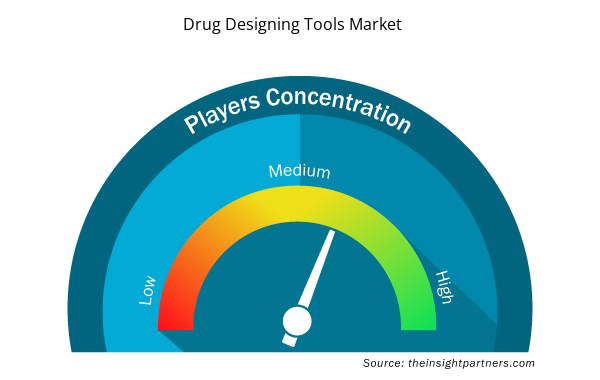The Drug Designing Tools Market is expected to register a CAGR of 8.9% from 2025 to 2031, with a market size expanding from US$ XX million in 2024 to US$ XX Million by 2031.
The report is segmented by Solution (Multi Databases, Virtual Screening Tools, Structure Designing Tools, Predictive Analytics, Model Building Tools, Others); Application (Chemical Screening, Molecular Modeling, Target Prediction, Binding Site Prediction, Docking, Energy Minimization, Others); End-User (Pharmaceutical Companies, Biotechnology Companies, Academic and Research Institutes, Contract Research Organizations, Others). The global analysis is further broken-down at regional level and major countries. The report offers the value in USD for the above analysis and segments
Purpose of the Report
The report Drug Designing Tools Market by The Insight Partners aims to describe the present landscape and future growth, top driving factors, challenges, and opportunities. This will provide insights to various business stakeholders, such as:
- Technology Providers/Manufacturers: To understand the evolving market dynamics and know the potential growth opportunities, enabling them to make informed strategic decisions.
- Investors: To conduct a comprehensive trend analysis regarding the market growth rate, market financial projections, and opportunities that exist across the value chain.
- Regulatory bodies: To regulate policies and police activities in the market with the aim of minimizing abuse, preserving investor trust and confidence, and upholding the integrity and stability of the market.
Drug Designing Tools Market Segmentation
Solution
- Multi Databases
- Virtual Screening Tools
- Structure Designing Tools
- Predictive Analytics
- Model Building Tools
- Others
Application
- Chemical Screening
- Molecular Modeling
- Target Prediction
- Binding Site Prediction
- Docking
- Energy Minimization
- Others
End-User
- Pharmaceutical Companies
- Biotechnology Companies
- Academic and Research Institutes
- Contract Research Organizations
- Others
Geography
- North America
- Europe
- Asia-Pacific
- South and Central America
- Middle East and Africa
Customize This Report To Suit Your Requirement
You will get customization on any report - free of charge - including parts of this report, or country-level analysis, Excel Data pack, as well as avail great offers and discounts for start-ups & universities
Drug Designing Tools Market: Strategic Insights

- Get Top Key Market Trends of this report.This FREE sample will include data analysis, ranging from market trends to estimates and forecasts.
Drug Designing Tools Market Growth Drivers
- Advancements in Computational Chemistry: The rapid advancements in computational chemistry are driving the growth of the drug designing tools market. Modern computational techniques, such as molecular modeling, docking simulations, and virtual screening, allow researchers to predict the behavior of molecules and optimize drug candidates before synthesis. These tools streamline the drug discovery process, reduce costs, and improve the efficiency of identifying potential therapeutics, fostering greater adoption of drug design software.
- Rising Demand for Personalized Medicine: As personalized medicine gains traction, there is a growing need for drug designing tools capable of tailoring therapies to individual genetic profiles. Computational drug design can analyze specific genetic variations to design personalized treatments for diseases like cancer and rare genetic disorders. This shift toward customized healthcare is driving demand for advanced drug designing platforms that can accommodate the complexity of individual patient data.
Drug Designing Tools Market Future Trends
- Integration of Artificial Intelligence (AI) and Machine Learning (ML): AI and machine learning are transforming the drug design process by improving predictive modeling, optimizing drug discovery workflows, and identifying novel drug candidates. AI algorithms can analyze vast datasets to uncover hidden patterns and predict the interactions between drug molecules and biological targets. This integration accelerates the drug design process, enhances the accuracy of predictions, and reduces the time required for drug development, making AI-powered tools a key trend in the market.
- Cloud-Based Drug Design Platforms: Cloud-based drug designing tools are gaining popularity due to their scalability, accessibility, and cost-effectiveness. These platforms enable researchers to access powerful computing resources, share data, and collaborate across geographies without the need for substantial on-premises infrastructure. The flexibility offered by cloud solutions is accelerating the adoption of drug designing tools, allowing pharmaceutical companies and research institutions to conduct complex simulations and analyses more efficiently and at a lower cost.
Drug Designing Tools Market Opportunities
- Growth of Biologics and Monoclonal Antibodies: The increasing focus on biologics, including monoclonal antibodies, offers significant opportunities for drug designing tools. These therapies are highly complex and require advanced tools for designing and optimizing proteins and antibodies. Drug designing platforms that specialize in biologics and protein-based therapies can help researchers predict structure-function relationships and streamline the development of these complex drugs, tapping into a rapidly growing market segment.
- Collaboration with Academic and Research Institutions: Drug designing tools have significant opportunities for collaboration with academic and research institutions. These collaborations enable the development of innovative drug design techniques and allow institutions to access cutting-edge tools for their research. By partnering with universities and research centers, drug designing tool providers can expand their customer base, enhance product development, and contribute to breakthroughs in drug discovery.
Drug Designing Tools Market Regional Insights
The regional trends and factors influencing the Drug Designing Tools Market throughout the forecast period have been thoroughly explained by the analysts at Insight Partners. This section also discusses Drug Designing Tools Market segments and geography across North America, Europe, Asia Pacific, Middle East and Africa, and South and Central America.

- Get the Regional Specific Data for Drug Designing Tools Market
Drug Designing Tools Market Report Scope
| Report Attribute | Details |
|---|---|
| Market size in 2024 | US$ XX million |
| Market Size by 2031 | US$ XX Million |
| Global CAGR (2025 - 2031) | 8.9% |
| Historical Data | 2021-2023 |
| Forecast period | 2025-2031 |
| Segments Covered |
By Solution
|
| Regions and Countries Covered | North America
|
| Market leaders and key company profiles |
Drug Designing Tools Market Players Density: Understanding Its Impact on Business Dynamics
The Drug Designing Tools Market market is growing rapidly, driven by increasing end-user demand due to factors such as evolving consumer preferences, technological advancements, and greater awareness of the product's benefits. As demand rises, businesses are expanding their offerings, innovating to meet consumer needs, and capitalizing on emerging trends, which further fuels market growth.
Market players density refers to the distribution of firms or companies operating within a particular market or industry. It indicates how many competitors (market players) are present in a given market space relative to its size or total market value.
Major Companies operating in the Drug Designing Tools Market are:
- Novo Informatics
- Biovia Corp.
- Schrodinger LLC
- Agilent Technologies
- Albany Molecular Research
Disclaimer: The companies listed above are not ranked in any particular order.

- Get the Drug Designing Tools Market top key players overview
Key Selling Points
- Comprehensive Coverage: The report comprehensively covers the analysis of products, services, types, and end users of the Drug Designing Tools Market, providing a holistic landscape.
- Expert Analysis: The report is compiled based on the in-depth understanding of industry experts and analysts.
- Up-to-date Information: The report assures business relevance due to its coverage of recent information and data trends.
- Customization Options: This report can be customized to cater to specific client requirements and suit the business strategies aptly.
The research report on the Drug Designing Tools Market can, therefore, help spearhead the trail of decoding and understanding the industry scenario and growth prospects. Although there can be a few valid concerns, the overall benefits of this report tend to outweigh the disadvantages.
- Historical Analysis (2 Years), Base Year, Forecast (7 Years) with CAGR
- PEST and SWOT Analysis
- Market Size Value / Volume - Global, Regional, Country
- Industry and Competitive Landscape
- Excel Dataset



Report Coverage
Revenue forecast, Company Analysis, Industry landscape, Growth factors, and Trends

Segment Covered
This text is related
to segments covered.

Regional Scope
North America, Europe, Asia Pacific, Middle East & Africa, South & Central America

Country Scope
This text is related
to country scope.
Frequently Asked Questions
Some of the customization options available based on the request are an additional 3-5 company profiles and country-specific analysis of 3-5 countries of your choice. Customizations are to be requested/discussed before making final order confirmation# as our team would review the same and check the feasibility
The report can be delivered in PDF/PPT format; we can also share excel dataset based on the request
The rise in R&D investment in pharmaceuticals sector and growing demand for personalized medicine are the major factors driving the drug designing tools market.
Incorporation of artificial intelligence and machine learning are likely to remain a key trend in the market.
The Drug Designing Tools Market is estimated to witness a CAGR of 8.9% from 2023 to 2031
Trends and growth analysis reports related to Technology, Media and Telecommunications : READ MORE..
1. Novo Informatics
2. Biovia Corp.
3. Schrodinger LLC
4. Agilent Technologies
5. Albany Molecular Research
6. Openeye Scientific Software
7. Chemaxon
8. BioSolveIT GmbH
9. Xtalpi Inc.
10. Perkinelmer

 Get Free Sample For
Get Free Sample For